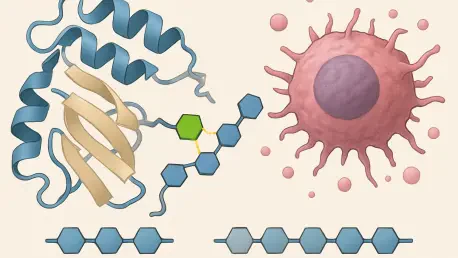In the intricate world of cellular biology, a silent player often dictates the fate of health and disease: enzymes that modify proteins on a molecular level, shaping their function in profound ways. One such enzyme, N-acetylglucosaminyltransferase-V, commonly referred to as GnT-V or MGAT5, has emerged as a critical focus in cancer research due to its role in selectively altering glycoproteins—proteins adorned with sugar molecules called glycans. This selective modification influences how cells communicate and function, often tipping the balance toward malignancy in conditions like cancer. The pressing question at the heart of recent research is why GnT-V targets specific glycoproteins over others, a mystery that holds the key to understanding disease progression.
This enigma of selectivity is not merely an academic pursuit; it carries profound implications for a spectrum of ailments beyond cancer, including Alzheimer’s, emphysema, and diabetes. Scientists have long grappled with deciphering the structural and cellular factors that guide GnT-V’s choices, as these modifications are pivotal in altering protein behavior within cells. Unraveling this puzzle could illuminate pathways to halt or redirect harmful cellular changes, offering hope for innovative treatments tailored to the molecular underpinnings of these diseases.
The challenge lies in the complexity of cellular environments where GnT-V operates. Factors such as the three-dimensional shape of target proteins and their positioning within cells add layers of intricacy to the enzyme’s decision-making process. Addressing these challenges through detailed study promises to bridge gaps in knowledge, potentially transforming how medical science approaches glycosylation-related disorders with precision and insight.
Background and Significance of GnT-V Research
GnT-V plays a vital role in N-glycan modification, a process that attaches complex sugar structures to proteins, thereby shaping their function and facilitating cell-to-cell communication. This modification is essential for maintaining normal cellular operations, but when GnT-V activity goes awry, it can fuel disease progression, particularly in cancer. Abnormal levels of this enzyme have been consistently linked to aggressive tumor growth and poor patient outcomes, underscoring its importance as a target for research.
The broader significance of studying GnT-V extends to its potential as a gateway for therapeutic breakthroughs. By understanding how this enzyme influences protein glycosylation, scientists aim to develop strategies that could interrupt harmful pathways in cancer and other conditions. Such advancements might lead to treatments that specifically target aberrant glycosylation, minimizing side effects and enhancing effectiveness compared to traditional approaches.
Moreover, delving into enzyme selectivity offers a window into the fundamental mechanisms of cellular biology. This research not only addresses immediate health concerns but also contributes to a deeper comprehension of how glycosylation impacts various disorders. As a cornerstone of glycoscience, insights into GnT-V could inspire a new era of medical interventions, focusing on personalized solutions for patients affected by these complex diseases.
Research Methodology, Findings, and Implications
Methodology
To explore the selectivity of GnT-V, researchers turned to mouse kidney tissue as a model system, providing a controlled environment to observe the enzyme’s behavior. This choice allowed for a detailed examination of how GnT-V interacts with glycoproteins in a physiologically relevant context. The study employed advanced techniques, including structural analysis to map the three-dimensional configurations of target proteins, shedding light on the physical traits that attract the enzyme’s attention.
Additionally, the team investigated subcellular trafficking within polarized cells, which have distinct top and bottom surfaces, to understand how cellular organization influences GnT-V activity. This approach revealed critical insights into the spatial dynamics that govern substrate selection. By focusing on these cellular pathways, the research captured a nuanced view of the enzyme’s preferences in a living system.
The study was a collaborative effort among esteemed Japanese institutions, including Gifu University and Osaka University, ensuring a robust framework for data collection and analysis. This partnership combined diverse expertise, enhancing the reliability of the findings through meticulous cross-verification. Such collaboration exemplifies the interdisciplinary nature of modern scientific inquiry, vital for tackling complex biological questions.
Findings
The research yielded significant discoveries about GnT-V’s selective behavior, revealing that the enzyme prioritizes glycoproteins based on their three-dimensional structure. This structural compatibility appears to be a primary determinant in the enzyme’s decision-making process. Furthermore, GnT-V showed a marked preference for proteins located at the apical surface of polarized kidney cells in mice, highlighting the role of cellular positioning in its activity.
Among the specific substrates identified, two metalloproteases stood out as key targets of GnT-V in mouse kidney tissue. These proteins, involved in breaking down other proteins with metal ion assistance, suggest that the enzyme may favor certain functional classes of glycoproteins. This finding provides a concrete starting point for understanding the types of proteins most likely to undergo modification by GnT-V.
However, the study also noted uncertainties regarding the broader applicability of these results. While cell polarity significantly influenced GnT-V activity in kidney tissue, it remains unclear whether this dependency holds true in other tissues or across different species. This limitation points to the need for expanded research to confirm the universality of the observed patterns.
Implications
Understanding the selectivity of GnT-V opens up exciting possibilities for predicting and even redesigning glycan structures on proteins for therapeutic purposes. By knowing which glycoproteins the enzyme targets and why, scientists could manipulate these interactions to counteract disease-related changes. Such precision could revolutionize approaches to managing conditions driven by abnormal glycosylation.
Particularly in cancer treatment, these insights hold promise for developing targeted interventions that alter glycan profiles to impede tumor progression. Modifying the activity of GnT-V or its substrates might offer a novel way to slow disease advancement, providing patients with more effective and less invasive options. This potential underscores the transformative impact of the research on clinical practice.
Beyond immediate applications, the study contributes significantly to the field of glycoscience by enhancing knowledge of enzyme-substrate interactions. It aligns with a growing emphasis on translational research, where scientific discoveries are directly applied to medical challenges. As such, this work serves as a catalyst for future innovations in treating glycosylation-related disorders.
Reflection and Future Directions
Reflection
Reflecting on the research process, one notable challenge was the limited scope of substrate identification, constrained by a focus on specific proteins within mouse kidney tissue. This narrow approach risked overlooking other potentially relevant glycoproteins that GnT-V might target under different conditions. Such a limitation highlights the complexity of comprehensively mapping enzyme activity across diverse biological contexts.
To address this, the researchers employed rigorous analytical methods to ensure the accuracy of their findings within the chosen model. Yet, the possibility of missing other substrates remains a concern, prompting a cautious interpretation of the results. This constraint emphasizes the importance of expanding the scope in subsequent studies to capture a fuller picture of GnT-V’s selectivity.
Another area for reflection is the potential to broaden the study’s design from the outset. Testing GnT-V behavior in varied tissues or across species could have provided a more comprehensive understanding of its mechanisms. While the current focus yielded valuable data, incorporating diverse biological systems might reveal additional layers of complexity in enzyme function.
Future Directions
Moving forward, further research is essential to elucidate the precise mechanisms driving GnT-V’s substrate selection. Investigating the molecular details of how structural features and cellular positioning interact could refine the current understanding. Such studies might uncover additional factors that influence the enzyme’s choices, enhancing the predictive power of these insights.
Another critical avenue is to explore whether the findings from mouse kidney tissue translate to human cells or other disease-relevant tissues. Comparative analyses across species and organ systems could validate the role of cell polarity in GnT-V activity, ensuring that therapeutic strategies are grounded in broadly applicable principles. This step is crucial for bridging the gap between animal models and clinical applications.
Lead researcher Professor Yasuhiko Kizuka envisions a future where these discoveries pave the way for revolutionary therapeutic glycan modifications. His vision includes harnessing detailed knowledge of GnT-V selectivity to design interventions that precisely target harmful glycosylation patterns. Pursuing this goal could transform the landscape of treatment for cancer and beyond, marking a significant leap in medical science.
Summarizing Insights and Impact on Glycoscience
The exploration of GnT-V selectivity has yielded pivotal insights into the structural and cellular factors guiding this cancer-linked enzyme’s behavior. Key discoveries include its preference for glycoproteins with specific three-dimensional shapes and localization at the apical surface of polarized kidney cells in mice, alongside the identification of two metalloproteases as primary substrates. These findings provide a foundational understanding of how GnT-V operates within a complex cellular milieu.
This research significantly advances the field of glycoscience by deepening the comprehension of glycosylation’s role in disease pathology. It highlights the intricate interplay between enzyme activity and cellular organization, offering a clearer view of how molecular modifications contribute to health and illness. Such knowledge is indispensable for developing targeted therapies that address the root causes of glycosylation disorders.
Looking ahead, this study establishes a robust platform for future innovations in cancer treatment and other medical domains. It marks a critical step toward harnessing enzyme selectivity for therapeutic gain, promising to inspire strategies that could fundamentally alter disease management. As glycoscience continues to evolve, these insights stand as a testament to the power of detailed scientific inquiry in driving progress.









